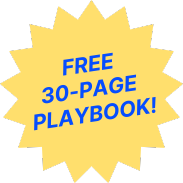Mastering the Call to Action: A Guide for Financial Advisors

When it comes to digital marketing, the call to action (or CTA) can be the difference between informing your audience and actually motivating them to take action.
On any given piece of marketing—whether it’s a social media ad, an email, or a webinar—the CTA is the second most critical line beneath only the headline or subject line in importance.
But often it can feel more like a call to confusion…where is this button taking me exactly? What am I signing up for? As a financial advisor, you know how important clarity and transparency are, so with that, here is our guide to mastering the call to action.
What Is a Call to Action?
You’ve probably seen a million CTAs in your life.
“Click Here” over a flashing button.
“Sign Up” at the bottom of an email.
“Get Started Now” at the end of a blog post.
The CTA is that last little ask that pushes people to engage. It’s a clear directive that helps convert passive visitors into active participants in your marketing funnel.
For financial advisors, a well-crafted CTA not only drives engagement but also guides potential clients toward taking meaningful steps in their financial journey. In this guide, we explore what a CTA is, why it’s crucial, and examine examples of effective and ineffective CTAs.
Why Is a Call to Action Important?
CTAs are the linchpins of successful marketing strategies for several reasons:
1. Guiding User Behavior
CTAs provide clear directions to your audience, telling them exactly what you want them to do next. Without a CTA, potential clients might not know the next steps, leading to missed opportunities to attract and engage.
2. Enhancing User Experience
A well-placed CTA enhances user experience by providing a logical next step. It eliminates guesswork, making it easier for visitors to navigate your offerings and engage with your services.
3. Increasing Conversion Rates
Effective CTAs are directly linked to higher conversion rates. By compelling visitors to take specific actions, you increase the likelihood of turning prospects into clients.
4. Measuring Success
CTAs also serve as measurable points within your marketing campaigns. By comparing the performance of various CTAs, you can gain insights into what drives your audience and refine your strategies accordingly.
Examples of Good and Bad CTAs
Great CTA Examples
“Schedule Your Free Financial Consultation Today”: This CTA is clear, offers immediate value (a free consultation), and creates urgency by using the word “today.” It tells the prospect exactly what to expect and why they should act now.
“Download Our Retirement Planning Guide”: This CTA promises a tangible benefit (a guide) and specifies the content’s relevance (retirement planning). It appeals to those seeking specific information, increasing the likelihood of engagement.
“Join Our Webinar on Investment Strategies”: It highlights an upcoming event, encouraging timely participation. The topic is clearly stated, attracting those interested in investment strategies.
“Get Your Personalized Financial Plan”: Personalization appeals to potential clients by offering a customized service, making it more attractive and relevant.
“Subscribe to Our Weekly Financial Tips”: This CTA offers ongoing value (weekly tips) and encourages a longer-term relationship through subscription.
Not-So-Great CTA Examples
“Click Here”: This CTA is vague and does not convey what the user will gain from clicking. It lacks motivation and specificity.
“Submit”: Does anyone like “submitting” anything? At best, it sounds stuffy and official. At worst, it means you’re being forced to obey.
“Contact Us”: This CTA is too general and passive. It doesn’t give a compelling reason or immediate benefit for why the user should contact you.
“Follow Us on Social Media”: Although useful for building an audience, it doesn’t provide a clear, immediate benefit. It’s more effective when paired with a specific reason, like “Follow Us for Daily Financial Tips.”
Crafting Effective CTAs for Financial Advisors
To create compelling CTAs, regardless of your marketing channel:
- Be clear and specific: Ensure your CTA clearly states what the user should do and what they will gain.
- Create urgency: Use words that convey urgency, such as “today,” “now,” or “limited time.”
- Highlight benefits: Focus on the value the user will receive by taking the action.
- Use action-oriented language: Use strong, action-oriented verbs to prompt immediate response.
- Test and refine: Continuously test different CTAs to see which performs best and refine your approach based on data.
How to Get High-Quality CTAs Built for You
(As Well As Every Other Aspect of Your Marketing Campaign)
By understanding the elements of good and bad CTAs, you can create marketing messages that not only engage your audience but also drive meaningful actions, ultimately leading to higher conversion rates and an elevated number of prospects willing to seek you out or pick up the phone.
However, many financial advisors don’t have the time or know-how to tackle the huge marketing projects that CTAs are a part of. For advisors who want the power of a robust marketing campaign but don’t want to dedicate the time to manage, launch and optimize it, there’s Indigo Marketing Agency.
Our sole specialty is creating persuasive online marketing campaigns for financial advisors and continually monitoring them to make sure they get results.
If you’re interested in learning more about how we can help, contact us and schedule your free consultation today!

Schedule Your Free Marketing Strategy Call Today
Check Out Our Related Video Content
Whether you’re a beginner or looking to improve your existing video marketing efforts, this webinar is designed to provide actionable insights and practical tips to make your videos a success.
At Indigo Marketing Agency, we help financial advisors embrace the evolving marketing landscape by utilizing custom video content. Read on for three reasons why you should incorporate video into your marketing strategy and how the Indigo team can help.
Connecting with your clients is of the utmost importance. But it can be really challenging in today’s digital age with all the noise. How are you supposed to stand out from the crowd?
FAQs
A call to action (CTA) is a clear directive that encourages visitors to engage and take specific actions, such as scheduling a consultation, downloading a guide, or joining a webinar. For financial advisors, a well-crafted CTA is crucial because it guides potential clients toward meaningful steps in their financial journey, enhances user experience, and increases conversion rates by turning prospects into clients.
CTAs guide user behavior by providing clear directions on the next steps, eliminating guesswork for the audience. This improves user experience by making it easier for visitors to navigate offerings and engage with services. A well-placed CTA enhances the overall user journey, ensuring visitors know exactly what to do and why they should do it.
Effective CTAs for financial advisors include:
- “Schedule Your Free Financial Consultation Today”: Clear, offers immediate value, and creates urgency.
- “Download Our Retirement Planning Guide”: Promises a tangible benefit and specifies relevance.
- “Join Our Webinar on Investment Strategies”: Highlights an upcoming event with a clear topic.
- “Get Your Personalized Financial Plan”: Offers customization, making it attractive and relevant.
- “Subscribe to Our Weekly Financial Tips”: Encourages a longer-term relationship through subscription.
Common mistakes to avoid include:
- “Click Here”: Vague and lacks motivation or specificity.
- “Submit”: Sounds stuffy and official, lacking appeal.
- “Contact Us”: Too general and passive, without a compelling reason or benefit.
- “Follow Us on Social Media”: Lacks a clear, immediate benefit and is more effective when paired with a specific reason.
Financial advisors can craft compelling CTAs by:
- Being clear and specific about what the user should do and what they will gain.
- Creating urgency with words like “today,” “now,” or “limited time.”
- Highlighting the benefits the user will receive by taking the action.
- Using action-oriented language with strong verbs to prompt immediate response.
- Testing and refining CTAs to see which performs best and adjusting based on data.



































